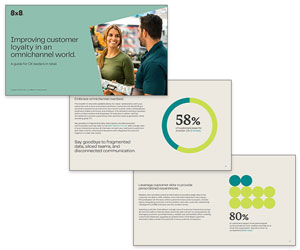Janice Rapp at 8×8 looks at the DNA of great experiences and engagement.
If I have learned anything about customer engagement during my decade-long tenure in the CX industry, it is that information silos prevent caterpillars from turning into butterflies.
Unlocking the value of customer data requires that communication and collaboration tools be baked into an organization’s customer engagement DNA. Especially if the company wants to leverage and transform data into truly actionable insights.
The reality is that customer service is no longer exclusive to the contact centre. This requires new thinking about constructing customer engagement programs.
After all, customer journeys today are often nonlinear, touching multiple channels and business units across the organization.
And within each of these business units are the support, sales, billing, and engineering employees (to name a few) interacting with customers.
Gartner now refers to this concept as “Total Experience,” which brings together customer experience, employee experience, as well as user experience, and multi-experience.
One of the key goals of “total experience” is to share the ownership of experiences in a way that both improves consistency and reduces friction across the customer journey.
This is more than omnichannel. And the sum is greater than the parts. In this article, we’ll explore how the right set of communication and collaboration tools can impact each of these experiences.
Microsoft Teams Considerations: Customer Engagement Strategies
If your organization has invested in Microsoft Teams, you might want to consider the role that Teams could and should play in your customer engagement strategies.
Teams by itself is not a complete customer engagement tool, but Teams integrated with a contact centre solution can provide tremendous results in terms of improving operational efficiencies and customer experience.
Contact centre leaders (along with IT) are asking themselves how they can use Teams in concert with their contact centre and unified communications solutions to streamline processes and create more efficiencies across the organization.
Disparate communication systems can create disconnects cross-departmentally, leaving employees and customers increasingly frustrated with the silos created by technology.
Having an integrated solution between your contact centre and Teams helps eliminate communication barriers while allowing team members–front office agents and back-office employees–to work together to quickly resolve customer issues and further collaborate.
What are other considerations worth weighing? When I speak with our customers about their customer engagement initiatives, a few broad topics always seem to bubble up to the top. Here are a few of them:
1. Analytics Everywhere
Contact centres live and die by analytics, but if you only collect data from within your contact centre, your insights could be like a mosaic with half its colors missing.
More business departments are exhibiting contact-centre-like behaviors, creating a need to capture that data and combine it into a single pool.
Additionally, some organizations create internal customer engagement programs though they may not have a dedicated contact centre. Their leaders increasingly want the same advanced tools that contact centre leaders have.
As a result of this need, vendors are introducing more apps that cover all employees, not just contact centre agents.
In fact, earlier this year 8×8 launched Conversation IQ, a quality management and speech analytics solution, to address this very need.
Interactions with sales and sales engineering get captured in the same mix as ones with contact centre agents. These kinds of benefits are why crushing silos is so important today. Let the data flow like water and let it work for you to see actionable insights.
2. Better Decisions, Better Outcomes From Collaboration and Customer Engagement
Why does collaboration matter across UCaaS, CCaaS, and Microsoft Teams? You want better outcomes, certainly, such as improved customer satisfaction scores (CSAT) and net promoter scores (NPS). These can lead to greater customer loyalty and revenue growth.
Beyond that, seamless collaboration enables managers to monitor customer interactions holistically to spot trends and identify what works well and what doesn’t.
The upshot is you can glean insights not to just train an individual about their performance, but also to improve cross-team performance. Wouldn’t it be nice to be able to define what makes a good handoff in your organization versus a bad one?
For many consumers, frustration often happens in the transitional moments, when you might be transferred to a new person who doesn’t have your information on their screen and you’re having to start from the beginning, wasting time and energy.
Seamless workflows across teams give managers opportunities to sync and optimize transitions better than a siloed approach, creating customer engagement wins. You cannot overestimate how much a unified approach levels up your quality, training, and coaching programs.
3. Cloud Versus On-Prem for Customer Engagement
The need to rapidly adopt new technologies at scale to support customer engagement initiatives is one factor motivating companies to move their systems off premises and into the cloud.
On-prem has limitations; cloud enables more agility, customization, reliability, and, of course, the ability to easily enable remote work. In fact, the power of AI is delivered through the cloud, as are new, intelligent capabilities such as robotic process automation (RPA).
Customer engagement programs are meant to evolve alongside changing business conditions and consumer expectations.
Cloud solutions are open and easily extensible through APIs, making it possible to build deeper integrations to customize your environment. You can test a variety of services without a massive implementation cycle.
In some ways, the cloud helps you pick the right dance partners for your business services, you want them all to be a good match that work together.
Again, collaboration and integration are so important to customer engagement because you need to master all your ideal workflows. The cloud is a great ally here.
4. On Multinationals
Seamless workflows can be even more important to multinational businesses because of collaboration requirements across multiple time zones and the International Date Line.
We find that it is critical for collaboration that all agents and customer-facing employees have phone numbers that are configured properly to enable a unified directory so every person can be reached.
Many companies offer a follow-the-sun support model featuring 24/7 service. These situations require smart and integrated hand-offs where customer data follows them to the next agent.
Your customer engagement solution must account for which communications tools employees and customers use in different countries. Another reason why collaboration, integration, and openness needs to be baked into your communications tools, especially for multinationals.
5. On Composable Business Applications for Better Employee, Customer Experiences
When I have referred to collaboration and integration, it has been on a macro level. But what is the next step after that? The next step is personalized experiences.
For employees, it means a user experience (UX) optimized for a particular role, such as what 8×8 has created for contact centre agents. 8×8 is continuing to develop additional composed and composable experiences for roles spanning the organization.
One of the things that make composable experiences work is an underlying UX where most of the look and feel is the same for everyone with tweaks specific to the composed role.
Composability is part of a larger software development trend of modular apps where tools can be connected like legos. So when considering your customer engagement solution, think about the connective tissue in your business communications tools.
Are they mostly open or closed? What offers you the most flexibility and simplicity to adapt, scale, innovate, and experiment, while also making life easier for your administrators.
Is collaboration built into your solution’s architecture?
6. On Customer and Employee Automated Self-Service Options
Research shows that many customers want self-service options. These benefit businesses too by reducing agent burden. So collaboration isn’t just between humans, but humans as well as virtual agents and intelligent assistants.
When constructed properly, interactive voice response (IVR) systems can really enhance customer experience. Enabling customers to ask questions online and receive answers instantly does too.
The key thing with self-service is figuring out how automation can reduce the time required to accurately solve a customer query, a metric called mean time to resolution (MTTR).
One of the elements that make up intelligent self-service options is its ability to learn and predict what a customer wants, but also to be able to access the right information from the right resources.
The technology is getting much better at understanding customer intent helping customers get to the right resources faster than ever.
Looking Forward: Contact Centre Predictions
We predict that by 2030, AI will drive verticalization in the contact centre industry to pinpoint each customer’s needs in a certain sector and then effectively carry them on a personalized journey with every brand.
As important as collaboration is to customer engagement today, I believe it will become even more important in the coming years.
I contributed to our Contact Centre Predictions for 2023 and Beyond report where we commented on the accelerating pace of innovation, the increasing global competitiveness, and the growing importance of employee experience (EX).
You know the old adage: take care of your employees so they can take care of your customers. In the world we live in today, it isn’t just a moral imperative, it is a business one too.
Did you know that not all caterpillars turn into butterflies? Some caterpillar transformations lead to moths instead. From a customer engagement perspective, it is collaboration DNA that leads to butterflies instead of moths. Good luck with your customer engagement transformations.
This blog post has been re-published by kind permission of 8x8 – View the Original Article
For more information about 8x8 - visit the 8x8 Website
Call Centre Helper is not responsible for the content of these guest blog posts. The opinions expressed in this article are those of the author, and do not necessarily reflect those of Call Centre Helper.
Author: 8x8
Published On: 15th Aug 2022
Read more about - Guest Blogs, 8x8






 8x8 is transforming the future of business communications as a leading Software-as-a-Service provider of voice, video, chat, contact centre, and enterprise-class API solutions, powered by one global cloud communications platform.
8x8 is transforming the future of business communications as a leading Software-as-a-Service provider of voice, video, chat, contact centre, and enterprise-class API solutions, powered by one global cloud communications platform. 
































